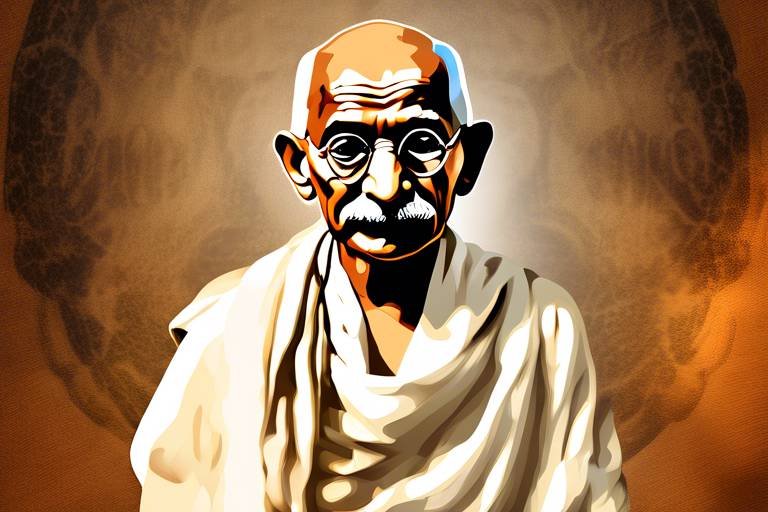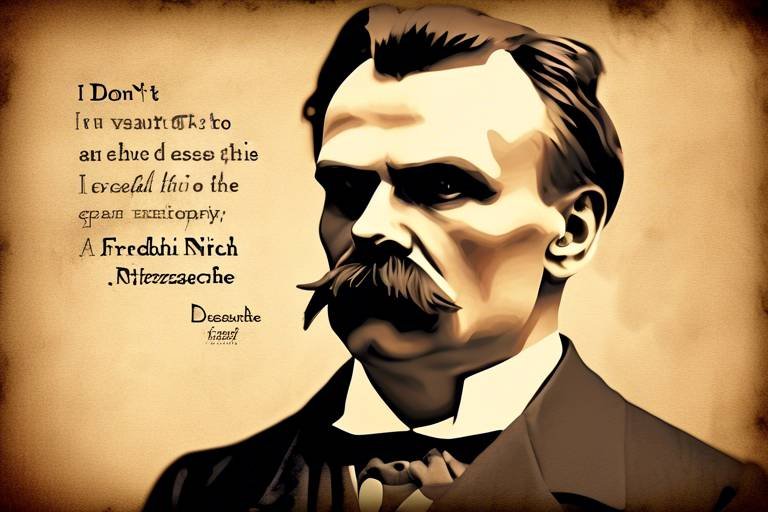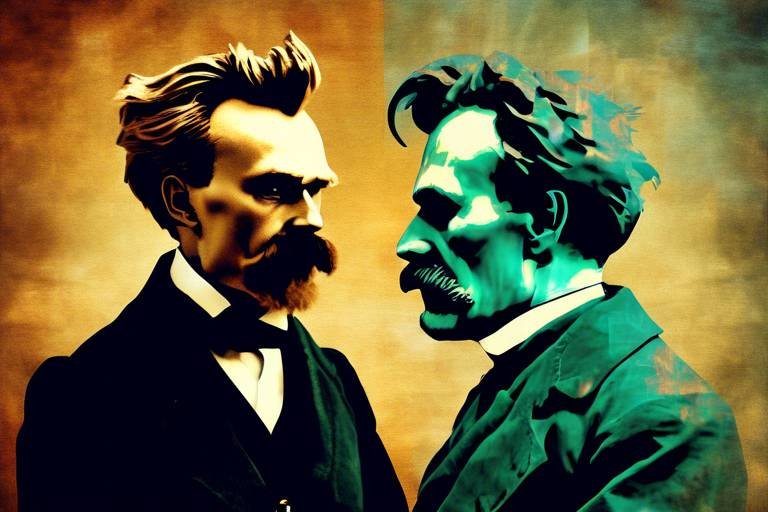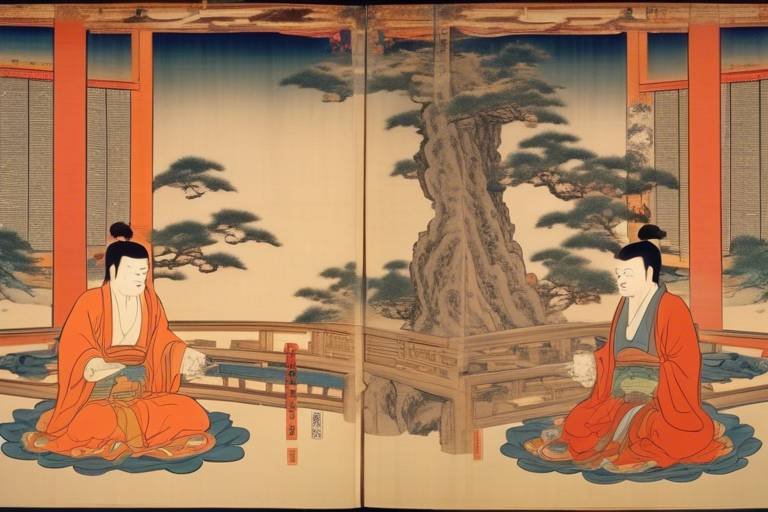An Overview of Roger Scruton's Aesthetic Philosophy
Roger Scruton, a prominent philosopher and cultural critic, delves into the intricate realm of aesthetics, shedding light on the profound significance of beauty and art in human existence. His aesthetic philosophy is not merely an academic exercise; it is a passionate exploration of how beauty shapes our lives, influences our moral compass, and connects us to one another. Scruton's work invites us to reconsider our understanding of art and its role in society, urging us to recognize that beauty is not just a fleeting pleasure but an essential element of our humanity. Through his lens, we uncover a world where aesthetics is intertwined with ethics, where our perceptions of beauty can lead to deeper insights about ourselves and the world around us.
At the heart of Scruton's philosophy lies the assertion that beauty transcends mere visual appeal. He posits that beauty serves as a reflection of deeper truths about existence, acting as a bridge that connects us to the sublime. This connection is not only emotional but also intellectual, prompting us to engage with art on multiple levels. Scruton challenges us to consider how our experiences of beauty can enrich our lives, fostering a sense of empathy and understanding that is often lacking in modern society. In a world that frequently prioritizes the superficial, his call to appreciate beauty is both refreshing and necessary.
Moreover, Scruton emphasizes that art is not just a form of self-expression; it is a moral endeavor that can shape our understanding of ethics and human relationships. He argues that through engaging with art, we can cultivate a deeper sense of responsibility towards others, as art has the power to evoke emotional responses that resonate within us. This emotional engagement is crucial, as it fosters a sense of connection and empathy, enabling us to understand the experiences of others.
As we navigate the complexities of contemporary life, Scruton's insights remind us of the importance of aesthetic experience. He urges us to open our eyes to the beauty that surrounds us, whether in nature, architecture, or the arts. By doing so, we can cultivate a more profound appreciation for the world and its inherent beauty, which can lead to a richer, more fulfilling existence.
In summary, Roger Scruton's aesthetic philosophy offers a compelling framework for understanding the role of beauty and art in our lives. By emphasizing the moral dimensions of art and the transformative power of aesthetic experience, he encourages us to embrace beauty as an essential part of our humanity. As we delve deeper into his ideas, we find ourselves challenged to reconsider our relationship with art and its potential to enrich our lives and society as a whole.
- What is Roger Scruton's main argument regarding beauty? Scruton argues that beauty transcends mere pleasure and serves as a fundamental aspect of our existence, reflecting deeper truths about the world.
- How does Scruton view the relationship between art and morality? He believes that art is a moral endeavor that influences our understanding of ethics and human relationships.
- Why is aesthetic experience important according to Scruton? Aesthetic experience is vital as it leads to a deeper appreciation of beauty and enriches our lives, fostering empathy and connection.
- What role does perception play in Scruton's philosophy? Perception is crucial because it links our ability to perceive beauty with our capacity for understanding and meaning.
- How does Scruton relate aesthetics to politics? He explores how aesthetic values intersect with political ideologies, suggesting that a society's appreciation for beauty can influence its moral and political landscape.

The Nature of Beauty
When we dive into Roger Scruton's aesthetic philosophy, one of the first things that hits us is his profound belief that beauty is not just skin deep. It transcends mere visual pleasure and taps into something much more significant—something that resonates with the very fabric of our existence. Scruton argues that beauty is a fundamental quality of the world, a reflection of deeper truths that we often overlook in our busy lives. Think about it: when was the last time you stood in awe of a breathtaking sunset or felt moved by a piece of music? These moments are not just fleeting pleasures; they are reminders of the beauty that surrounds us and how it connects us to something greater.
Scruton emphasizes that our appreciation of beauty can serve as a bridge to understanding complex concepts about life, morality, and our place in the universe. He posits that beauty has a unique ability to evoke a sense of wonder and curiosity, prompting us to explore the world and our feelings about it. This exploration is not merely an aesthetic experience; it is a journey into the depths of human emotion and understanding. In fact, he suggests that our capacity to perceive beauty is intertwined with our ability to grasp meaning in our lives.
To illustrate this, consider how different cultures and societies have historically defined beauty. From the intricate designs of ancient architecture to the delicate strokes of a painting, beauty often reflects the values and beliefs of a community. Scruton argues that this cultural dimension of beauty is crucial. It shapes our identities and influences how we relate to one another. When we appreciate beauty, we're not just reacting to an image or sound; we're engaging with a shared human experience that transcends time and geography.
Moreover, Scruton believes that beauty has a moral dimension. It can inspire us to strive for goodness, truth, and harmony in our lives. In a world that sometimes feels chaotic and disordered, beauty acts as a guiding light, reminding us of the potential for joy and connection. This moral aspect of beauty is not just philosophical; it has real-world implications. For instance, when we create or engage with art that embodies beauty, we are participating in a process that can elevate our understanding of ourselves and our relationships with others.
In conclusion, Scruton's exploration of beauty invites us to reconsider our perceptions and interactions with the world around us. Beauty isn't just a passive experience; it's an active engagement that shapes our thoughts, feelings, and actions. So, the next time you encounter something beautiful, take a moment to reflect on what it means to you. What truths does it reveal? How does it connect you to others? In Scruton's view, these questions are essential for a richer, more meaningful life.

Art as a Moral Endeavor
When we think about art, we often imagine beautiful paintings, stirring music, or captivating performances. However, Roger Scruton challenges us to consider art through a different lens: one that emphasizes its moral dimensions. In his view, art is not just a form of expression; it is a moral undertaking that can profoundly shape our understanding of ethics and human relationships. This perspective invites us to explore how art can serve as a vehicle for moral reflection and social commentary.
Scruton contends that the act of creating and engaging with art is inherently tied to our ethical frameworks. Art has the power to illuminate the human condition, providing insights into our shared experiences, struggles, and triumphs. By reflecting on these themes, artists can challenge societal norms and provoke thought, encouraging audiences to reconsider their values and beliefs. For instance, consider how a powerful film or a thought-provoking novel can inspire us to empathize with others, fostering a deeper understanding of diverse perspectives.
Moreover, art can serve as a catalyst for social change. Throughout history, artists have used their platforms to address pressing social issues, from poverty and injustice to war and inequality. This moral aspect of art is vital, as it can mobilize communities and inspire action. Scruton emphasizes that when we engage with art, we are not merely passive consumers; instead, we become active participants in a dialogue about what it means to live a good life.
To illustrate this point, let's explore some key ways in which art functions as a moral endeavor:
- Fostering Empathy: Art can evoke emotions that allow us to connect with others on a profound level. Whether it’s a poignant painting or a moving piece of music, art can break down barriers and foster understanding.
- Challenging Norms: Artists often push boundaries, questioning societal norms and provoking thought. This can lead to greater awareness and, ultimately, change.
- Reflecting Human Experience: Through various mediums, art captures the essence of what it means to be human, allowing us to reflect on our values and beliefs.
In Scruton's eyes, the moral implications of art extend beyond the individual artist. Society as a whole benefits when we engage with art that challenges us, encourages reflection, and promotes dialogue. This is particularly important in today's world, where we face numerous challenges that require collective action and ethical consideration. By valuing art as a moral endeavor, we can cultivate a culture that prioritizes empathy, understanding, and social responsibility.
In conclusion, Scruton's perspective on art as a moral endeavor invites us to reconsider our relationship with art. It encourages us to see beyond aesthetics and recognize the profound impact that art can have on our moral landscape. As we engage with art, we are not just appreciating beauty; we are participating in a conversation about what it means to be human, to care for one another, and to strive for a better world.
- What does it mean for art to be a moral endeavor? Art as a moral endeavor suggests that art has the power to influence our values, provoke thought, and inspire social change.
- How can art foster empathy? Art evokes emotions and allows us to connect with different perspectives, helping us to understand and empathize with others' experiences.
- In what ways can artists challenge societal norms? Artists can use their work to question established beliefs and provoke discussions on important social issues, encouraging audiences to think critically.

Aesthetic Experience
When we think about , it’s easy to get lost in the whirlpool of emotions, sensations, and perceptions that art evokes within us. Roger Scruton emphasizes that engaging with art is not merely a passive act; rather, it’s an immersive journey that can transform our understanding of beauty and enrich our lives in profound ways. Imagine standing before a breathtaking painting, where every brushstroke seems to whisper secrets of the universe, or listening to a symphony that resonates with the very core of your being. This is the essence of aesthetic experience—it’s about connection, reflection, and the awakening of our senses.
Scruton argues that aesthetic experiences are deeply personal and subjective, yet they also hold a universal quality that can foster a sense of shared humanity. When we encounter beauty in art, we are often moved to explore our own emotions and thoughts, leading to a richer understanding of ourselves and the world around us. This is where the magic happens: through art, we can engage in a dialogue with our own feelings, as well as with those of others. It’s like a mirror reflecting not just our faces, but our souls.
Furthermore, Scruton believes that the act of perceiving beauty is intricately linked to our capacity for meaning-making. The aesthetic experience encourages us to delve deeper into our perceptions, challenging us to ask questions like, “What does this artwork mean to me?” or “How does this piece resonate with my life experiences?” In this way, art becomes a catalyst for exploration, prompting us to engage in a more profound conversation with ourselves and our surroundings.
To illustrate this point, consider the following aspects of aesthetic experience:
- Emotional Engagement: Art has the power to evoke a range of emotions, from joy to sorrow, and everything in between. This emotional engagement is what makes aesthetic experiences so impactful.
- Intellectual Reflection: Encountering beauty often leads us to reflect on complex ideas and themes, encouraging critical thinking and deeper understanding.
- Social Connection: Sharing aesthetic experiences with others can foster empathy and strengthen our bonds, as we connect over shared feelings and interpretations.
In essence, the aesthetic experience is a multifaceted phenomenon that goes beyond the surface of beauty. It invites us to engage fully with our senses, emotions, and intellect, creating a tapestry of understanding that enriches our lives. Scruton’s insights remind us that art is not just something to admire from afar; it is a vital part of our human experience, capable of transforming our perceptions and deepening our connections with the world and each other.
- What is aesthetic experience? Aesthetic experience refers to the engagement with art that evokes emotions, reflections, and deeper understanding of beauty.
- How does art influence our emotions? Art can elicit a wide range of emotional responses, allowing us to connect with our feelings and those of others.
- Why is aesthetic experience important? It enriches our lives, fosters empathy, and enhances our understanding of the world around us.

The Role of Perception
When we dive into the depths of Roger Scruton's aesthetic philosophy, one of the most striking elements is his emphasis on the role of perception in our experience of beauty. Perception isn't just a passive act; it's an active engagement with the world around us. Imagine standing in front of a breathtaking painting or gazing at a stunning landscape. It's not merely the colors or the forms that captivate us; it's how we perceive them that transforms the experience into something profound. Scruton argues that our ability to perceive beauty is intricately linked to our capacity for understanding and meaning, much like how a well-crafted story pulls us in and makes us feel connected to its characters.
In Scruton's view, perception is a gateway to a deeper appreciation of art. It invites us to slow down and really absorb what we see, feel, and think. This engagement can lead to a myriad of emotional responses, enriching our lives in ways we often overlook. When we perceive beauty, we are not just consuming art; we are participating in a dialogue with it. This dialogue can evoke memories, stir emotions, and even challenge our preconceived notions. For example, a piece of music might remind us of a significant moment in our lives, making the experience of listening not just about sound, but about connection and reflection.
Moreover, Scruton highlights that perception is not merely an individual experience; it can also be a shared one. When we appreciate beauty collectively—be it through art, architecture, or nature—we forge connections with one another. This shared perception fosters a sense of community and belonging. It's similar to how a group of friends might gather to watch a movie; their collective reactions enhance the experience, making it memorable. Thus, the role of perception transcends the individual, creating a tapestry of shared experiences that enrich our cultural and social fabric.
To further illustrate Scruton's point, consider the following aspects of perception in relation to beauty:
- Subjectivity: Each person's perception is shaped by their unique experiences and emotions, making beauty a deeply personal encounter.
- Context: The environment in which we perceive beauty can significantly affect our experience. A painting in a gallery feels different than the same painting viewed in a cluttered room.
- Awareness: Being mindful of our surroundings enhances our perception. When we take a moment to breathe, observe, and reflect, we open ourselves to a richer experience of beauty.
In conclusion, Scruton's exploration of perception reveals its crucial role in our interaction with beauty and art. It’s not just about what we see; it’s about how we see it. Our perceptions shape our understanding of the world and ourselves, creating a profound relationship between beauty and our human experience. So next time you find yourself in front of a piece of art or a scenic view, take a moment to immerse yourself fully in the experience. Ask yourself: what does this beauty mean to me? How does it resonate with my life? In doing so, you may discover layers of meaning that enrich your understanding of both art and your place in the world.
- What is the significance of perception in Scruton's philosophy?
Perception is vital as it shapes our understanding and appreciation of beauty, transforming passive observation into active engagement. - How does perception affect our emotional responses to art?
Our perceptions can evoke memories and emotions, making our experience of art deeply personal and meaningful. - Can perception be shared among individuals?
Yes, shared perceptions can foster community and connection, enhancing our collective experience of beauty.

The Emotional Response
When we engage with art, we often find ourselves swept away by a tide of emotions. Roger Scruton emphasizes that this emotional response is not merely a superficial reaction; it is a profound connection that art fosters between the viewer and the piece. Imagine standing before a breathtaking painting, feeling a rush of nostalgia or joy. This is the magic of art; it resonates with our innermost feelings and experiences, often reflecting our personal stories. Scruton argues that art has the power to evoke empathy, allowing us to step into the shoes of others, to feel their joys and sorrows as if they were our own.
Consider how a haunting melody can transport you to a different time and place, stirring memories you thought were long buried. This emotional engagement is crucial in Scruton's philosophy, as it underscores the idea that art is not just a passive experience. Instead, it actively shapes our emotional landscape, influencing how we relate to the world and to one another. Through art, we can explore complex feelings that words alone may fail to capture. It's like a mirror reflecting the depths of our humanity, revealing truths that might otherwise remain hidden.
Moreover, Scruton posits that these emotional responses can lead to a greater sense of community. When we share our feelings about a piece of art, we create a bond with others who have had similar experiences. This shared emotional journey fosters a sense of belonging and understanding, bridging gaps between individuals from diverse backgrounds. In a world that often feels fragmented, art serves as a unifying force, reminding us of our shared humanity.
In essence, the emotional responses elicited by art are not just fleeting moments of pleasure; they are integral to our understanding of beauty and meaning. They challenge us to reflect on our values, our relationships, and our place in the world. As Scruton eloquently suggests, engaging with art can enrich our lives, providing us with insights that resonate long after the initial experience has faded. So, the next time you encounter a piece of art, take a moment to pause and reflect on the emotions it stirs within you. What stories does it tell? How does it connect you to others? The answers to these questions may lead you to a deeper appreciation of art's role in our lives.
- What is Roger Scruton's main argument about beauty?
Scruton argues that beauty is an essential quality that transcends mere pleasure, serving as a fundamental aspect of our existence. - How does art influence our understanding of ethics?
Scruton believes that art is a moral undertaking that can shape our understanding of ethics and human relationships. - Why is emotional response important in Scruton's philosophy?
Emotional responses to art foster empathy and connection with others, enriching our lives and understanding of beauty. - What role does art play in society according to Scruton?
Art serves various functions, from providing solace to challenging societal norms, and plays a vital role in shaping cultural identity. - How does modernism affect our perception of beauty?
Scruton argues that modernism often neglects traditional notions of beauty, leading to a disconnection between art and the human experience.

The Function of Art in Society
Art is not merely a decorative element or an afterthought in our lives; it serves multiple essential functions within society. From the ancient cave paintings that told stories of survival to modern installations that challenge our perceptions, art has always been a vital part of human existence. It acts as a mirror, reflecting our values, struggles, and aspirations. Just think about it: when you visit a museum or stumble upon a street mural, what do you feel? That emotional jolt is art doing its job, connecting us to our shared humanity.
One of the primary roles of art is to provide solace and comfort. In times of distress, whether personal or societal, art can be a refuge. It offers a way to process emotions, to express what might be too painful to articulate in words. For instance, consider how music can lift our spirits during tough times or how a poignant film can help us navigate grief. This therapeutic aspect of art is crucial; it reminds us that we are not alone in our experiences.
Moreover, art serves as a catalyst for social change. It has the power to challenge the status quo, provoke thought, and inspire action. Throughout history, artists have used their platforms to address pressing social issues, from civil rights to environmental concerns. For example, the powerful imagery of protest art can galvanize communities, urging them to confront injustices and advocate for change. Art, in this sense, is not just a reflection of society but a powerful tool for transformation.
Additionally, art plays a significant role in shaping cultural identity. It helps us understand who we are as a community and what we value. Traditional art forms often carry the weight of history and heritage, while contemporary art can express the evolving nature of our society. By engaging with different art forms, we gain insight into various cultures and perspectives, fostering a sense of empathy and understanding. This cultural exchange enriches our lives and strengthens the social fabric.
In conclusion, the functions of art in society are as diverse as the art itself. It provides solace, inspires change, and shapes our cultural identity. As Roger Scruton suggests, recognizing these roles can deepen our appreciation for art and its significance in our lives. So next time you encounter a piece of art, whether it’s a song, a painting, or a performance, take a moment to reflect on its impact and the myriad ways it connects us to one another.
- What is the primary role of art in society? Art provides solace, inspires change, and helps shape cultural identity.
- How can art influence social change? Art can challenge societal norms and provoke thought, motivating individuals to advocate for change.
- Why is cultural identity important in art? Cultural identity helps us understand our values and fosters empathy through engagement with diverse perspectives.

The Relationship Between Aesthetics and Politics
Roger Scruton delves into the intricate relationship between aesthetics and politics, suggesting that the appreciation of beauty can significantly influence a society's moral compass and political ideologies. In his view, aesthetic values are not merely personal preferences but are deeply intertwined with our collective identity and ethical frameworks. When we consider how beauty manifests in art, architecture, and even in nature, it's evident that these experiences shape our perceptions of the world and, consequently, our political beliefs.
Scruton argues that societies that prioritize aesthetic appreciation tend to cultivate a greater sense of community and shared values. For instance, when citizens engage with beautiful public spaces or art that resonates with their cultural heritage, they are more likely to develop a sense of pride and responsibility towards their community. This connection can foster a more cohesive society, where individuals are motivated to participate actively in political processes and advocate for the common good.
Moreover, the political implications of aesthetics can be seen in how regimes utilize art and beauty to promote their ideologies. Totalitarian governments, for instance, often manipulate aesthetic values to create propaganda that glorifies their rule, while democratic societies may harness the power of art to challenge the status quo and inspire social change. Scruton emphasizes that art can serve as a double-edged sword, capable of both uplifting the human spirit and serving as a tool for oppression.
In exploring the impact of modernism, Scruton highlights a troubling trend: the neglect of traditional notions of beauty in favor of avant-garde expressions that sometimes alienate the public. This shift can lead to a disconnection between art and the lived experiences of individuals, resulting in a political landscape where citizens feel estranged from cultural dialogues. When art fails to resonate with the masses, it risks becoming an elitist endeavor, further widening the gap between different societal groups.
To remedy this disconnection, Scruton advocates for a return to traditional aesthetic values that emphasize beauty, harmony, and meaning. He believes that by restoring these values, we can not only enrich our understanding of art but also strengthen the moral fabric of our society. Aesthetic experiences can inspire empathy, foster dialogue, and encourage us to engage with our communities in meaningful ways. In this sense, the relationship between aesthetics and politics is not just theoretical; it is a lived experience that shapes our identities and informs our responsibilities as citizens.
Ultimately, Scruton's exploration of aesthetics and politics invites us to reflect on the power of beauty in our lives. It challenges us to consider how our engagement with art and culture can influence our political beliefs and behaviors. As we navigate an increasingly complex world, recognizing the significance of aesthetics may very well be key to fostering a more just and harmonious society.
- How does Scruton's philosophy relate to modern society? Scruton's ideas encourage a renewed appreciation for beauty and its role in shaping our moral and political landscapes.
- What is the impact of aesthetics on political ideologies? Aesthetics can influence our values and beliefs, affecting how we engage with our communities and the political system.
- Why is traditional aesthetic value important? Traditional values provide a deeper understanding of art and foster connections within society, promoting empathy and community engagement.

The Impact of Modernism
Modernism has had a profound impact on the landscape of art and aesthetics, often reshaping our perceptions and interactions with beauty. Scruton argues that this movement, which emerged in the late 19th and early 20th centuries, has frequently overlooked traditional notions of beauty. Instead of celebrating the harmonious and the sublime, modernism often embraced abstraction, fragmentation, and a sense of disconnection. This shift can be likened to a ship sailing away from the familiar shores of beauty, leaving behind the very essence that once anchored our understanding of art.
While modernist artists sought to break free from conventions, Scruton suggests that in doing so, they inadvertently created a chasm between art and the human experience. The emotional resonance that art once held began to fade, replaced by a cold intellectualism that left many viewers feeling alienated. This disconnection raises critical questions: What happens to our appreciation of art when we lose sight of beauty? Can we still find meaning in art that prioritizes form over feeling?
To illustrate this point, consider the following aspects of modernism's impact:
- Abstraction Over Representation: Modernist artists like Picasso and Kandinsky often favored abstract forms, which some argue can obscure the emotional depth traditionally found in representational art.
- Fragmentation: The modernist approach frequently involves breaking down objects into parts, which can lead to a loss of unity and coherence, leaving audiences puzzled rather than inspired.
- Intellectualism: Many modernist works prioritize intellectual engagement over emotional connection, which can alienate viewers who seek a more relatable experience with art.
Scruton contends that this modernist ethos can lead to a cultural landscape where beauty is dismissed as irrelevant or outdated. In a world where art no longer reflects the human condition or engages with our emotional lives, we risk losing a vital connection to our shared humanity. This is particularly concerning in a society that increasingly values the aesthetic experience as a means of fostering empathy and understanding.
However, Scruton doesn't argue for a wholesale rejection of modernism. Instead, he advocates for a balanced approach that acknowledges the innovations of modernist thinkers while simultaneously restoring a focus on beauty and emotional resonance. By doing so, we can create a richer dialogue between the old and the new, allowing art to serve as a bridge that connects us to our past and to one another.
In conclusion, the impact of modernism on aesthetics is a double-edged sword. While it has undoubtedly pushed the boundaries of artistic expression, it has also led to a disconnection from the essential qualities of beauty that Scruton holds dear. As we navigate this complex terrain, we must strive to reclaim beauty in our appreciation of art, ensuring that it continues to play a vital role in our lives.
- What is modernism in art? Modernism is an artistic movement that emerged in the late 19th and early 20th centuries, characterized by a departure from tradition and a search for new forms of expression.
- How does Scruton view beauty in art? Scruton believes that beauty is a fundamental aspect of existence and that art should engage with this quality to foster a deeper understanding of human experience.
- Can modernism and traditional aesthetics coexist? Yes, Scruton advocates for a balance between modernist innovations and traditional values, suggesting that both can enrich our understanding of art.

Restoring Traditional Values
In the whirlwind of modernity, where everything seems to be in a constant state of flux, Roger Scruton stands as a beacon advocating for the restoration of traditional aesthetic values. He argues that these values are not just relics of the past, but rather, they hold the key to a richer understanding of art and its role in our lives. Imagine walking through a gallery filled with contemporary art that, while visually striking, often leaves you feeling disconnected or perplexed. Now, contrast that with the timeless beauty of classical works that resonate with deep emotional and intellectual truths. This is the essence of Scruton's argument: traditional values in art can ground us and provide a sense of continuity in an ever-changing world.
Scruton suggests that by embracing traditional aesthetics, we can cultivate a deeper appreciation for beauty that transcends mere surface pleasure. He believes that art should not only be experienced but also understood in its historical and cultural context. This understanding fosters a connection to our heritage and to the shared human experience. When we engage with art that reflects traditional values, we are not just looking at a painting or a sculpture; we are engaging with a narrative that has shaped our civilization. It’s like reading a classic novel that speaks to the human condition—each page resonates with the struggles, joys, and aspirations that define us.
Moreover, Scruton emphasizes that traditional aesthetic values can serve as a counterbalance to the often chaotic and fragmented nature of modern life. In a world inundated with rapid change and fleeting trends, these values provide a sense of stability and reassurance. They remind us of the beauty in craftsmanship, the significance of form and harmony, and the emotional depth that art can convey. It’s akin to returning to a familiar, comforting place after a long journey; the sense of belonging and understanding is both profound and necessary.
To illustrate this point, consider the following table that contrasts traditional and modern aesthetic values:
| Aspect | Traditional Aesthetic Values | Modern Aesthetic Values |
|---|---|---|
| Beauty | Timeless and harmonious | Subjective and often chaotic |
| Craftsmanship | Highly valued and respected | Often overlooked |
| Emotional Depth | Profound and relatable | Can be superficial |
| Cultural Significance | Rich in history and context | Frequently disconnected from tradition |
By restoring traditional values in aesthetics, we can not only enhance our appreciation of art but also enrich our lives. Scruton encourages us to seek out beauty that challenges us, moves us, and connects us to our shared humanity. It’s an invitation to step back from the noise and chaos of contemporary life and engage with art that speaks to our souls. When we do this, we find ourselves not just as passive observers but as active participants in a dialogue that spans generations.
Ultimately, Scruton's call to restore traditional values is about more than just art; it’s about cultivating a society that values beauty, depth, and meaning. In a world that often prioritizes the ephemeral, his philosophy reminds us of the enduring power of aesthetics to shape our lives and our communities. So, the next time you encounter a piece of art, ask yourself: does it resonate with the beauty of tradition, or does it merely reflect the fleeting trends of modernity? The answer might just lead you to a more profound understanding of both art and yourself.
- What are traditional aesthetic values? Traditional aesthetic values refer to the enduring qualities of beauty, craftsmanship, and emotional depth that have been celebrated in art throughout history.
- Why are traditional values important in modern art? They provide a sense of continuity and stability, allowing individuals to connect with their cultural heritage and the shared human experience.
- How can I appreciate traditional aesthetics in my daily life? Seek out experiences that engage with classical art, music, and literature, and reflect on how they resonate with your own emotions and understanding of beauty.

Conclusion: The Relevance of Scruton's Philosophy
In a world that often seems chaotic and fragmented, Roger Scruton's aesthetic philosophy offers a much-needed anchor. His insights into beauty and art encourage us to pause and reflect on what truly matters in our lives. Scruton reminds us that beauty is not just a superficial quality; it is a profound aspect of our existence that connects us to deeper truths about the world around us. By recognizing beauty in our everyday experiences, we cultivate a sense of meaning and purpose.
Moreover, Scruton's assertion that art is a moral endeavor resonates strongly in today’s society. As we navigate through complex ethical dilemmas and social issues, art can serve as a powerful tool for empathy and understanding. It challenges us to reflect on our values and the relationships we share with others. In this light, engaging with art becomes more than just a pastime; it transforms into a crucial part of our moral landscape.
Scruton's emphasis on the aesthetic experience further highlights its significance in enriching our lives. Whether it’s a moving piece of music, a breathtaking painting, or a thought-provoking film, these experiences can evoke emotions and foster connections that transcend the mundane aspects of daily life. They remind us of our shared humanity and can inspire us to strive for a better world.
As we look towards the future, the relevance of Scruton's philosophy becomes even more pronounced. In an age dominated by modernism and often a disregard for traditional values, his advocacy for a return to these principles offers a pathway to restoring a sense of cultural identity. By embracing traditional aesthetic values, we can cultivate an appreciation for beauty that not only enriches our individual lives but also strengthens the fabric of our society.
Ultimately, Scruton's work invites us to engage with art and beauty in a way that is both personal and communal. It encourages us to ask ourselves: How do we perceive beauty? How does it shape our understanding of the world? As we ponder these questions, we may find that embracing Scruton's aesthetic philosophy can lead to a more fulfilling and meaningful existence.
- What is Roger Scruton's main argument about beauty? Scruton argues that beauty is an essential quality that transcends mere pleasure and reflects deeper truths about our existence.
- How does Scruton view the role of art in society? He sees art as a moral endeavor that influences our understanding of ethics and fosters connections between individuals.
- What does Scruton say about modernism? Scruton believes that modernism has often neglected traditional notions of beauty, leading to a disconnection between art and the human experience.
- Why is Scruton's philosophy still relevant today? His ideas encourage a renewed appreciation for beauty and art as essential components of human experience and societal well-being.
Frequently Asked Questions
- What is Roger Scruton's view on beauty?
Roger Scruton believes that beauty is not just a superficial pleasure; it's a profound quality that reflects deeper truths about our existence. He argues that beauty transcends mere enjoyment and is essential to our understanding of the world.
- How does Scruton define the role of art in society?
Scruton sees art as a moral endeavor that can influence our ethical understanding and human relationships. He emphasizes that art serves various functions, from providing comfort to challenging societal norms, thus playing a crucial role in shaping cultural identity.
- What is the significance of aesthetic experience according to Scruton?
Aesthetic experience is vital for Scruton as it allows individuals to engage deeply with art, leading to a richer appreciation of beauty. This engagement can enhance our lives and foster a greater connection to the world around us.
- How does perception affect our understanding of beauty?
Scruton argues that our ability to perceive beauty is intricately linked to our capacity for understanding and meaning. He suggests that perception is not just about seeing; it's about interpreting and finding significance in what we experience.
- What role does emotional response play in Scruton's philosophy?
Emotional responses to art are central to Scruton's philosophy. He posits that our feelings towards beauty can enhance empathy and foster connections with others, highlighting the relational aspect of aesthetics.
- How does Scruton relate aesthetics to politics?
Scruton explores the intersection of aesthetic values and political ideologies, suggesting that a society's appreciation for beauty can shape its moral and political landscape. He believes that aesthetics can influence societal norms and values.
- What are Scruton's views on modernism in art?
Scruton critiques modernism for often neglecting traditional notions of beauty, leading to a disconnect between art and the human experience. He advocates for a return to these traditional values to restore a deeper understanding of art.
- Why is Scruton's aesthetic philosophy still relevant today?
Scruton's aesthetic philosophy remains pertinent as it encourages a renewed appreciation for beauty and art. He argues that these elements are fundamental to human experience and societal well-being, urging people to recognize their importance in contemporary life.



















